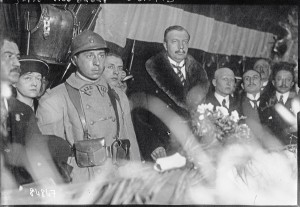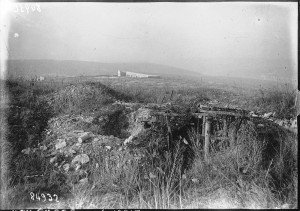 The constant heavy artillery bombardments that took place during the battle of Verdun had transformed the battlefield into a devastated corpse-ridden landscape scene of mass death and total destruction, a wasteland of mud full of dismembered human remains. By the end of 1916, French losses were 61,000 dead, 101,000 missing and 216,000 wounded.
The constant heavy artillery bombardments that took place during the battle of Verdun had transformed the battlefield into a devastated corpse-ridden landscape scene of mass death and total destruction, a wasteland of mud full of dismembered human remains. By the end of 1916, French losses were 61,000 dead, 101,000 missing and 216,000 wounded.
 During the same year, François Simon, President of the Rennes section of the French Remembrance Society, proposed that the remains of an unidentified dead French soldier be laid at rest in the Panthéon in Paris in commemoration of the thousands of dead men who were denied a proper burial.
During the same year, François Simon, President of the Rennes section of the French Remembrance Society, proposed that the remains of an unidentified dead French soldier be laid at rest in the Panthéon in Paris in commemoration of the thousands of dead men who were denied a proper burial.
On 8 November 1920, following the wish of French veterans’ organizations who favoured the Arc de Triomphe, members of French Parliament voted unanimously in favour of the transfer to Paris of the remains of one of the unknown soldiers who fell on the field of honour during the 1914-1918 war and his burial under the Arc de Triomphe. There is a symbolic dimension to the fact that the selection was made from eight identical coffins, each bearing the remains of a soldier fallen on the field of honour and placed in an underground casemate of the Citadel of Verdun. The ceremony took place on 10 November under the supervision of French minister of Pensions André Maginot, a WWI veteran who received a severe leg wound in Maucourt-sur-Orne, near Verdun in November 1914.
 On 11 November 1923, the Flame of Remembrance was lit for the first time on the Tomb of the Unknown French Soldier. It has been rekindled each night ever since. Since 1980, on the first day of November of each year, members of the Committee of the Voie Sacrée and the Voie de la Liberté bring the eternal flame to Verdun and place it in the crypt of the Monument for the Victory where its burns until 11 November.
On 11 November 1923, the Flame of Remembrance was lit for the first time on the Tomb of the Unknown French Soldier. It has been rekindled each night ever since. Since 1980, on the first day of November of each year, members of the Committee of the Voie Sacrée and the Voie de la Liberté bring the eternal flame to Verdun and place it in the crypt of the Monument for the Victory where its burns until 11 November.


Ajouter un commentaire